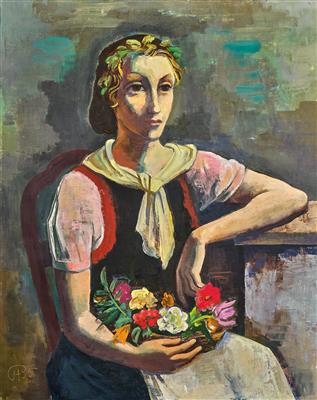Karl Hofer *

(Karlsruhe 1878–1955 Berlin)
Flowergirl, 1935, artist’s monogram, dated CH35, inscribed, titled on the stretcher, oil on canvas, 101 x 80.5 cm, framed
Provenance:
Nierendorf Galleries, New York
The Toledo Museum of Art, Toledo/Ohio, Inv.-No. 38.43 (gift from Edward Drummond Libbey)
Sotheby’s, New York, 7. May 2003, lot 362
Private Collection, Germany
Exhibited:
Galerie Nierendorf, Berlin 1937, no. 16
Pittsburgh 1937 (The 1937 International Exhibition of Paintings),
no. 353
Westerman Art Gallery, New York 1938
The Toledo Museum of Art 1938, no. 46
Institute of Modern Art, Boston 1939, p. 17, no. 19
Carnegie Institute, Pittsburgh 1940, no. 12
G. M. V. Smith Gallery, Springfield/Mass. 1941, no. 9, vol. 1, p. 20 (ill.) D. P. Allen Memorial Art Museum, Oberlin/Ohio 1946, no. 12
Institute of Modern Art, Boston 1946
Art Gallery of Toronto/Toledo Museum of Art 1948, no. 16
Birmingham Museum of Art, Birmingham/Alabama 1956, no. 52
Literature:
Karl Bernhard Wohlert, Karl Hofer – Werkverzeichnis der Gemälde, vol. 2, Cologne 2007, no. 1116 with ill.
From the 1920s to the 1940s, young girls in particular were a popular subject for the Expressionist artist Karl Hofer. Many of them have as their attribute a flower in different variations. The flower is a symbol of young life and positions the women portrayed accordingly. These, however, appear dreamy and isolated from the dynamic outside world. They are presented in a diffuse space without a background worth the mention. The protagonists’ gaze is usually directed into the distance, having no set focus or a point of communication with the surroundings. Even though Hofer chose the motif of the young girl with flowers many times, the works vary greatly in their execution.
The flower girl illustrated here stands out as the first work in the series of flower girls. Painted in 1935, it shows a young woman sitting sideways at a chair at the table. Having placed her left arm loosely on the table top, with her right arm she embraces the flower basket on her lap. Clad in a fashionable dress, she has her hair tied up in an elegant hairstyle and around her head she wears a wreath of flowers. The young woman seems introverted and lost in her thoughts. Her gaze steers characteristically out of the picture, past the viewer, into emptiness. Hofer is concerned solely with the person, the forms, the colours and the expression that defines them. The picture conveys an aura of sensuality and melancholy, which impressively contrasts with the concise and painterly reduced formal language.
“At the centre of his artistic work were man and the human figure in all its facets: the bathing female body, emaciated men among ruins and the lonely figures around the barely warming campfire of misery”.
(http://www.karl-hofer.de/oeuvre.php, 25.09.2020)
Specialist: Dr. Petra Maria Schäpers
 Dr. Petra Maria Schäpers
Dr. Petra Maria Schäpers
petra.schaepers@dorotheum.de
24.11.2020 - 16:00
- Estimate:
-
EUR 120,000.- to EUR 150,000.-
Karl Hofer *
(Karlsruhe 1878–1955 Berlin)
Flowergirl, 1935, artist’s monogram, dated CH35, inscribed, titled on the stretcher, oil on canvas, 101 x 80.5 cm, framed
Provenance:
Nierendorf Galleries, New York
The Toledo Museum of Art, Toledo/Ohio, Inv.-No. 38.43 (gift from Edward Drummond Libbey)
Sotheby’s, New York, 7. May 2003, lot 362
Private Collection, Germany
Exhibited:
Galerie Nierendorf, Berlin 1937, no. 16
Pittsburgh 1937 (The 1937 International Exhibition of Paintings),
no. 353
Westerman Art Gallery, New York 1938
The Toledo Museum of Art 1938, no. 46
Institute of Modern Art, Boston 1939, p. 17, no. 19
Carnegie Institute, Pittsburgh 1940, no. 12
G. M. V. Smith Gallery, Springfield/Mass. 1941, no. 9, vol. 1, p. 20 (ill.) D. P. Allen Memorial Art Museum, Oberlin/Ohio 1946, no. 12
Institute of Modern Art, Boston 1946
Art Gallery of Toronto/Toledo Museum of Art 1948, no. 16
Birmingham Museum of Art, Birmingham/Alabama 1956, no. 52
Literature:
Karl Bernhard Wohlert, Karl Hofer – Werkverzeichnis der Gemälde, vol. 2, Cologne 2007, no. 1116 with ill.
From the 1920s to the 1940s, young girls in particular were a popular subject for the Expressionist artist Karl Hofer. Many of them have as their attribute a flower in different variations. The flower is a symbol of young life and positions the women portrayed accordingly. These, however, appear dreamy and isolated from the dynamic outside world. They are presented in a diffuse space without a background worth the mention. The protagonists’ gaze is usually directed into the distance, having no set focus or a point of communication with the surroundings. Even though Hofer chose the motif of the young girl with flowers many times, the works vary greatly in their execution.
The flower girl illustrated here stands out as the first work in the series of flower girls. Painted in 1935, it shows a young woman sitting sideways at a chair at the table. Having placed her left arm loosely on the table top, with her right arm she embraces the flower basket on her lap. Clad in a fashionable dress, she has her hair tied up in an elegant hairstyle and around her head she wears a wreath of flowers. The young woman seems introverted and lost in her thoughts. Her gaze steers characteristically out of the picture, past the viewer, into emptiness. Hofer is concerned solely with the person, the forms, the colours and the expression that defines them. The picture conveys an aura of sensuality and melancholy, which impressively contrasts with the concise and painterly reduced formal language.
“At the centre of his artistic work were man and the human figure in all its facets: the bathing female body, emaciated men among ruins and the lonely figures around the barely warming campfire of misery”.
(http://www.karl-hofer.de/oeuvre.php, 25.09.2020)
Specialist: Dr. Petra Maria Schäpers
 Dr. Petra Maria Schäpers
Dr. Petra Maria Schäpers
petra.schaepers@dorotheum.de
|
Buyers hotline
Mon.-Fri.: 10.00am - 5.00pm
kundendienst@dorotheum.at +43 1 515 60 200 |
| Auction: | Modern Art |
| Auction type: | Saleroom auction with Live Bidding |
| Date: | 24.11.2020 - 16:00 |
| Location: | Vienna | Palais Dorotheum |
| Exhibition: | online |
